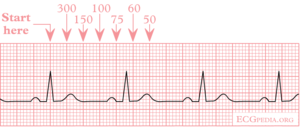Rate: Difference between revisions
No edit summary |
|||
| (64 intermediate revisions by 14 users not shown) | |||
| Line 1: | Line 1: | ||
{{ | {{nav| | ||
== | |previouspage=Rhythm | ||
[[Image:ECGpapier.png|thumb| The width of a square on the ECG represents time]] | |previousname=Step 1: Rhythm | ||
[[Image:Ecgfreq.png|thumb| | |nextpage=Conduction | ||
|nextname=Step 3:Conduction intervals (PQ, QRS, QT, QTc) | |||
}} | |||
[[Image:ECGpapier.png|thumb|300px| The width of a square on the ECG represents time]] | |||
[[Image:Ecgfreq.png|thumb|300px| The count method to determine the heart frequency. The second QRS complex is between ''75'' and ''60'' beat per minute. This heartbeat is between that, around 65 beats per minute.]] | |||
'''What is the heart rate?''' | |||
To answer this question, determine the time between two QRS complexes. Previously, the ECG was printed on a paper strip transported through an ECG writer at the speed of 25 mm/second. Now, digital ECGs are common; however, the method for determining the frequency remains the same. The ECG has a grid with thick lines 5 mm apart (= 0,20 second) and thin lines 1 mm (0,04 second). | |||
There are three simple methods to determine the heart rate (HR) | |||
{| class="wikitable" | |||
!The square counting method | |||
|- | |||
| The '''square counting''' method is ideal for regular heart rates. Use the sequence 300-150-100-75-60-50-43-37. Count from the first QRS complex, the first thick line is 300, the next thick line 150 etc. Stop the sequence at the next QRS complex. When the second QRS complex is between two lines, take the mean of the two numbers from the sequence or use the fine-tuning method listed below. | |||
|} | |||
{| class="wikitable" | |||
!Use a calculator | |||
|- | |||
| Count the small (1mm) squares between two QRS complexes. The ECG paper runs at 25 mm/sec through the ECG printer; therefore:[[Image:HFformule_en.png|none]]This method works well in case of tachycardia (>100 beats/minute)<br> | |||
|} | |||
{| class="wikitable" | |||
!The marker method | |||
|- | |||
| | |||
Non-regular rhythms are best determined with the "3 second marker method". Count the number of QRS complexes that fit into 3 seconds (some ECG writers print this period on the ECG paper). Multiply this number by 20 to find the number of beats/minute. | |||
|} | |||
{| class="wikitable" font-size="90%" align="center" | |||
|+'''The 'square counting' method can be fine-tuned with the following sequence''' | |||
|- | |||
|'''300'''||250||214||187||167||'''150'''||136||125||115||107||'''100'''||94||88||83||79||'''75'''||71||68||65||62||'''60''' | |||
|- | |||
|} | |||
{{clr}} | {{clr}} | ||
== | ==What changes the frequency of the heart?== | ||
A number of factors change the heart frequency, including: | |||
* | * the (para) sympathic nervous system. | ||
** | ** The '''sympathic system''', e.g. epinephrine, (=adrenalin) increases atrioventricular conduction and contractility (the ''fight or flight'' reaction.) | ||
** | ** The parasympathic system (nervus vagus,) e.g. acetycholine, decreases the frequency and atrioventricular conduction. The parasympathic system affects mainly the atria. | ||
* | * Cardiac filling increases the frequency. | ||
* [[arrhythmias]] influence heart rate. | |||
[[Category:ECG Course]] | |||
Latest revision as of 19:51, 15 March 2011
| «Step 1: Rhythm | Step 3:Conduction intervals (PQ, QRS, QT, QTc)» |


What is the heart rate? To answer this question, determine the time between two QRS complexes. Previously, the ECG was printed on a paper strip transported through an ECG writer at the speed of 25 mm/second. Now, digital ECGs are common; however, the method for determining the frequency remains the same. The ECG has a grid with thick lines 5 mm apart (= 0,20 second) and thin lines 1 mm (0,04 second).
There are three simple methods to determine the heart rate (HR)
| The square counting method |
|---|
| The square counting method is ideal for regular heart rates. Use the sequence 300-150-100-75-60-50-43-37. Count from the first QRS complex, the first thick line is 300, the next thick line 150 etc. Stop the sequence at the next QRS complex. When the second QRS complex is between two lines, take the mean of the two numbers from the sequence or use the fine-tuning method listed below. |
| The marker method |
|---|
|
Non-regular rhythms are best determined with the "3 second marker method". Count the number of QRS complexes that fit into 3 seconds (some ECG writers print this period on the ECG paper). Multiply this number by 20 to find the number of beats/minute. |
| 300 | 250 | 214 | 187 | 167 | 150 | 136 | 125 | 115 | 107 | 100 | 94 | 88 | 83 | 79 | 75 | 71 | 68 | 65 | 62 | 60 |
What changes the frequency of the heart?
A number of factors change the heart frequency, including:
- the (para) sympathic nervous system.
- The sympathic system, e.g. epinephrine, (=adrenalin) increases atrioventricular conduction and contractility (the fight or flight reaction.)
- The parasympathic system (nervus vagus,) e.g. acetycholine, decreases the frequency and atrioventricular conduction. The parasympathic system affects mainly the atria.
- Cardiac filling increases the frequency.
- arrhythmias influence heart rate.
